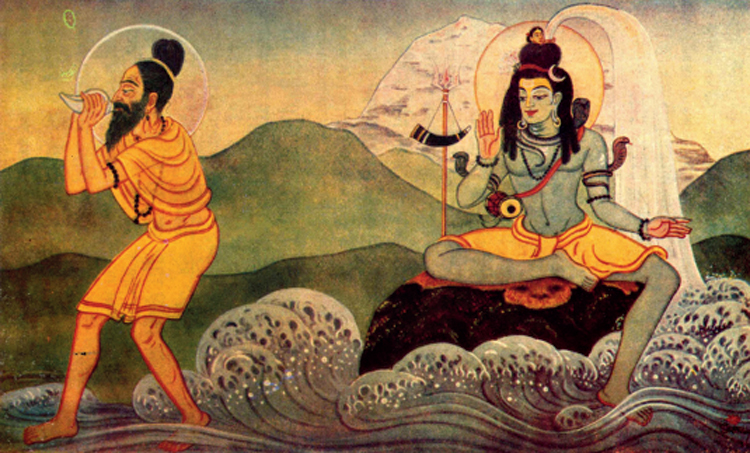In this erudite and intricately woven work, Sudipta Sen lucidly captures the essence of Indian civilization from antiquity to the present through a detailed discourse on its most important watercourse. Ganga: The Many Pasts of a River is not just an account of historical occurrences within the Ganga valley, but shows how the river, in physical form and as a mythological-religious entity, is deeply enmeshed in the Indian consciousness with its anthropomorphic and naturalistic conceptions vital to the construing of the history and culture of this region.
Examining the sacredness accorded to the Ganga, Sen weaves together myths, histories, accounts of religious artefacts and geographical descriptions to indicate why this river has been revered by Hindus as a metaphysical threshold, capable of cleansing all sins and providing deliverance from mortal existence to a spiritual afterlife. The tale of its descent from the heavens — recorded in the Ramayana — in response to the pleas of Bhagiratha so that the last rites of his ancestors could be performed lends further resonance to this theme. The interspersing of mythical accounts with natural landscapes serves to show how these events are internalized in the cultural milieu. The Ganga’s banks have thus been the focus of funerals and pilgrimages over millennia, with the waters worshipped for seemingly miraculous healing properties, either as a result of faith or with actual scientific understanding of the existence of bactericidal phages. Mass gatherings along the Ganga have defined and reshaped city architectures and riverfronts, and created their own cosmic geography of sacred space and time which govern human interactions with the river and also conceive spiritual landmarks along its sides.
Alongside the Indus as a crucible of Indian civilization, the timeline of human occupancy of the Ganga valley assumes special significance. Sen collates extensive information from archaeological digs, geological and palaeoclimatic accounts to piece together the conditions that existed for early hominids in the prehistoric Ganga basin. Details of mesolithic sites and tools and neolithic pottery, evidence from sedimentological, palaeontological and pollen analysis together with cutting-edge dating techniques, trace the transition of early settlers from hunter-gatherer-foragers to sedentary agriculturists, highlighting the changes brought about by the use of iron in domestic implements and weaponry. The emergence of garrisoned settlements along the Ganga’s west-east axis was an outcome of agricultural surplus, and their absorption into the warring city-states that arose in the east was concomitant with the rise of Jainism and Buddhism over the old Vedic order. Multiple dynasties that occupied the Ganga’s tracts seeking control over its course, confluences and sacred sites for prestige, religious symbolism and political power underpin the river’s importance, as both actor and stage, in shaping India’s political and religious geography. The riverside became a vibrant concourse of traders, travellers and pilgrims; taxing the movement of goods along it formed a major revenue source.
Later Turkish conquests in the Ganga valley and the establishment of the Delhi Sultanate, the appearance of European traders in outposts along the Bengal delta, mercantile rivalries and the growing clout of the East India Company are explained succinctly and chronologically by Sen. The ownership of the Ganga’s agrarian heartland — comprising the present-day states of Uttar Pradesh and Bihar — has thus historically been a prerequisite for the rise of almost every powerful political entity in the country and underlain the dominance, growth and prosperity of that realm. That this heartland continues to hold such sway in determining modern India’s polity underlines the Ganga’s continued geographical, sociopolitical and economic importance.
Extensive human occupation of the Ganga’s realm fostered a social hierarchy of farm owners, cultivators and labourers, and transformative changes in the original land cover occurred from the cumulative effects of expanding irrigation, agriculture, industry and population. Sen traces recorded alterations from Kautilya’s Arthashastra to the irrigation schemes of the Mughals. The Great Bengal Famine of 1769-1773 led to further restructuring of landholdings by the British through the 1793 Permanent Settlement of Bengal Act and reinstated the importance of the Ganga as a conduit for water supply and grain transport. River engineering schemes were thus taken up extensively during British rule, reflected in the construction of the Ganges Canal at Haridwar and the extensive surveys pioneered by James Rennell to chart the river’s course and judge its suitability for inland navigation. The constructed canal, aqueducts and causeways reconfigured the Ganga’s waterscape and the advent of the railways reconnected distant parts of its basin.
In independent India, the preponderance of multi-purpose river valley projects in the Ganga basin have further harnessed the river, giving rise to contentious dam-related issues and concerns about maintaining environmental flows and arresting pollution. Grand plans to cleanse the river have floundered and been re-framed. Sen asks if it will survive the burden of human and industrial contaminants and the yokes of dams and barrages. He concludes by highlighting the dual perception of the Ganga, as a vital resource for sustenance and economic progress that opens it to exploitation even while it is venerated as an icon of Indianness and a wellspring of spirituality. This dissociation between the physical state of this waterbody and the preordained mental image of the river lies at the heart of how this riverscape is negotiated in everyday life, juxtaposing concepts of cleanliness versus impurity and science versus faith.
With its maps, notes and photographs, Sen’s authoritative volume is both informative and engaging. The vivid narrative feels like a journey through time, visiting the Ganga basin in different epochs to visualize the socio-ecological changes wrought by the rise and fall of empires and technological progress. Akin to Eric Newby and Julian Crandall Hollick’s accounts of their journeys down the Ganga, Sen’s Ganga presents a history of each of its segments while creating a kaleidoscope of the Indian civilization and its shared ethos. It can only be hoped that India’s national river receives its just dues from the country it has so faithfully nourished.
Ganga: The Many Pasts of a River; By Sudipta Sen, Viking, Rs 799











